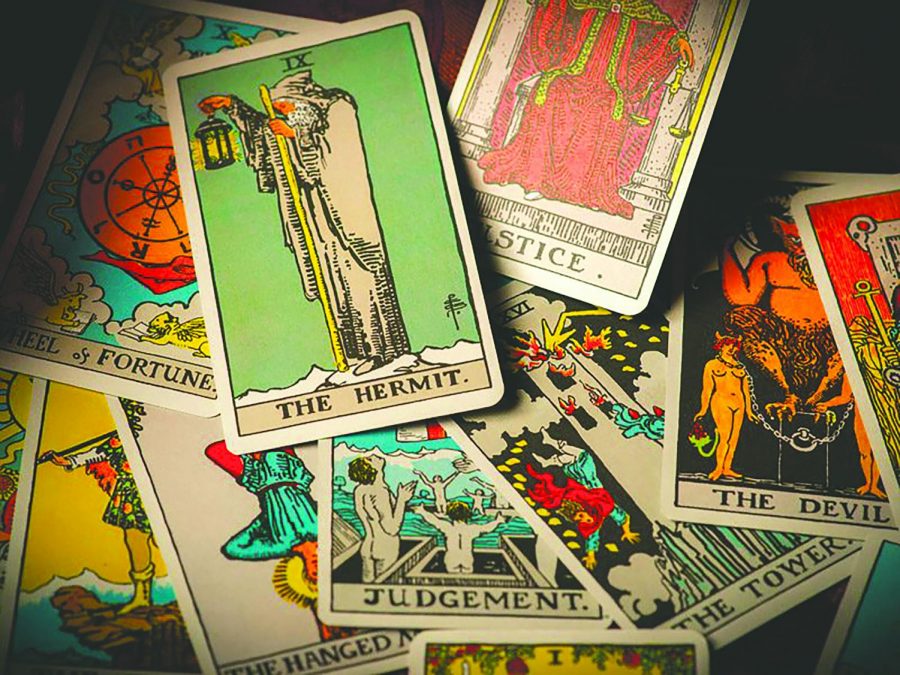How do tarot cards actually work?
Learn all about tarot cards and how they work through this short introduction
Photo by Submitted
OPINION: Tarot cards were the original playing cards of the 15th century. Learning more about them is a great way to explore history and learn more about yourself at the same time.
When most people think of tarot cards, they think of psychics, magic and astrology. All of these things are connected to autumn and the spookiness of Halloween.
But what actually are tarot cards?
Tarot Cards were the original playing cards of the mid-15th century from which the more recognizable playing cards used today were developed. Only more recently did tarot evolve into the divination tool as we know it to be today.
When used as a tool for divination, the cards of a tarot deck can be read like a storybook, designed to help you navigate through the circumstances of your life and reflect on those things in ways you may not have thought of before.
Similar to playing cards, tarot cards have four different suits of 14 cards: wands, cups, swords and pentacles. These suits are known collectively as the minor arcana.
Each card in the minor arcana represents a different moment, a specific instance or people of different temperaments in your life. The different suits correspond to distinct regions in your life.
For example, the suit of wands represents creative resources, the suits of cups represents emotions, the suit of swords represents your mind and the suit of pentacles represents material resources.
Unlike typical playing cards, tarot cards also have an additional 22 cards known as the major arcana. This makes the total number of cards in a typical tarot deck 78 cards.
The major arcana represent significant moments in your life. These cards are slightly more powerful than the minor arcana because they can affect the meaning of the minor arcana in a reading.
The first card of the major arcana — the fool card — acts as the protagonist for the story of the major arcana. The cards that follow the fool card represent different parts of the fool’s life.
Now that you have a basic understanding of the cards found in tarot decks, let’s figure out how tarot card readings actually work and how they can be used to help guide your life.
There is no right or wrong way to read tarot cards. Reading tarot is a mixture of understanding the meanings of the cards and using your intuition to find what you feel is the meaning of each card.
One of the fun things about tarot is one card can have multiple meanings depending on the reading you are doing. Figuring out what its meaning is depends on what you feel like the meaning could be.
For beginners of tarot, it is usually recommended to start by using the Rider-Waite tarot deck. This deck uses the original images of tarot cards and is helpful when first learning the meanings of the cards.
When getting ready to do a tarot reading, you should have a question in mind. This can be something you are curious about with your life or something you want advice for.
Once you have your question in mind, shuffle the cards in any way you see fit. The cards that pop out and the cards you feel drawn to pull are the ones you should include in your reading.
After you have your cards, look at each card individually and try to feel what the card means to you. You can always double-check what you think the meaning of the card is with the guidebook that comes with the tarot deck. Both meanings are valid.
The meanings of each card can then be strung together into a story format to give you the possible answers to your question.
With Halloween quickly approaching and many of the paid psychics around town being fully booked, learning to read tarot is a great way to give yourself the psychic reading you’ve always wanted.
Smith can be reached at [email protected]..

Chloe Smith is a third-year English and multimedia communications student. This is her second semester on The Spectator team. In her free time she likes to read, binge watch TV shows, spend time with her dog and listen to music.


Raj • May 22, 2023 at 7:50 am
First developed in the 14th century, tarot cards were originally used to play games. In the 18th century, they began to be used for divination purposes and in the early 20th century, they became popular in the United States.
Olivia Smart • Sep 15, 2022 at 2:00 pm
Thank you for explaining how tarot cards can be ready like a storybook when they’re used for divination. I’ve been really curious about these since my daughter had a reading done. I’ll have to go with her next time or get my own reading done to see how it works. https://www.psychicplacebymrseve.com/
Shammy Peterson • Sep 5, 2022 at 2:55 am
It sure was helpful when you said that you must take note of what you want advice for when getting ready for a tarot card reading. My husband is interested in tarot reading since he needs help in career-making decisions before leaving the country in November. I will ask him to consider speaking with a telephone psychic reader before this month ends so he can be guided well based on the readings. https://pyramid-of-enlightenment.com/psychic-telephone-reading/
Sharma • Dec 17, 2021 at 6:11 am
It’s great to read your post! In your examination of this topic, you provide a lot of useful information. You have done an excellent job sharing this information, and I want to thank you for it.. https://www.bestpsychichealers.com
Amber • Nov 28, 2021 at 1:12 pm
A very interesting article! 🙂
Shammy Peterson • Jul 29, 2021 at 10:43 pm
It caught my attention when you said that tarot reading involves the use of your intuition to find what you feel is the meaning of each card and understanding the meaning of the cards. With this in mind, I would rather speak with a professional tarot reader so I could get sense sensible insights rather than relying on my own understanding. What I want is to know if resigning from my job would lead me to a better future since I feel so burned out. To be honest, I don’t have strong intuition. https://www.gracespsychics.com.au/tarotreadinglovetarotreadingtarotcardreading